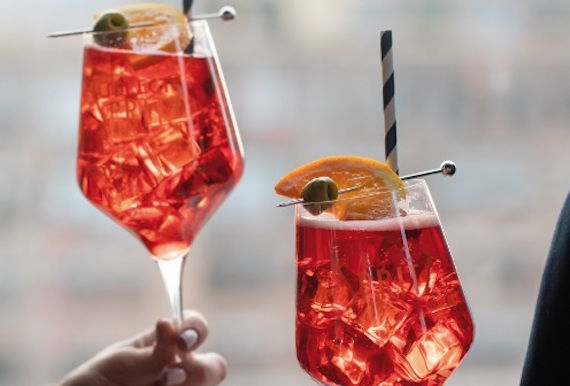It’s worth taking a detour to examine the origins of the Spritz, which were largely driven by two large technological innovations. While the name comes from the German ‘spritzen’, to spray – a relic of the Austro-Hungarian occupation of northern Italy in the 1800s that saw occupying soldiers adding a dash of water to the local Italian still wines – the Spritz as we know it didn’t begin to take shape until around 1915. That’s when, according to Italian spirits historian Fulvio Piccinino, technological innovation number one, soda syphons, became widespread in Italian bars, and the Austro-Hungarian practice of adding water to still wine morphed into adding a squirt of fizzy water to said still wine, because who doesn’t like a bit of tableside theatre?
By the 1920s, this tradition had enlarged to include adding a little – initially just a few drops – of a local bitter such as Campari, Select or Aperol, depending on whether you were in Milan, Venice, or Padua. And so chugged along the Spritz until, as documented in the 2016 book Spritz by Talia Baiocchi and Leslie Pariseau, the 1990s. Charmat-methode, innovation number two, describes a secondary fermentation for sparkling wines occurring in a stainless-steel tank instead of in the bottle, dating to 1895.
The widespread adoption of this innovation by prosecco producers in the late 1970s and 1980s, and the resultant wave of value-priced yet high-quality prosecco brands, set the table for the vertical ascent in popularity of prosecco, both on the beaches of Italy and abroad. From there it was logical to have prosecco replace the still wine in a Spritz, and the Spritz proper - aperitivo bitter, prosecco and fizzy water – was born.
IMPRESSIVE SALES
Bacardi’s Martini division share the bitter optimism – its premium range, Martini Riserva Speciale, launched a Martini Bitter at 2017’s Tales of the Cocktail in New Orleans, and reports impressive sales in heritage markets such as Italy and France along with the UK and Russia. Roberta Mariani, Martini’s global brand ambassador, thinks the widespread adoption of bitter flavours stems from healthier diets: “We are moving away from sugar and we are integrating our diets with more plants, which most of the time present some bitterness.”
Over in France, Pernod-Ricard’s Lillet continues to grow steadily, both at home and abroad, especially in Germany (the top market), the US and Austria. The French group is investing heavily in a responsible-drinking message that emphasises low-alcohol Lillet drinks, food pairing and conviviality. Lillet is clearly playing the long game with this messaging – it would be all too easy for it to fall back on the Vesper cocktail, an Ian Fleming creation that hit the silver screen again in 2006’s Casino Royale.
But the Vesper features an eye-watering 100ml of full-strength alcohol as well as half a shot of Lillet in Fleming’s original recipe – enough to make any secret agent forget his mission. Another Pernod-Ricard brand, the Italian Ramazzotti, might not be making any waves, but it still sold 1.2m cases in 2018 – not to be sneezed at for a brand as venerable as Ramazotti, which dates to 1815.
Not that the big brands have it all their own way. One of the oldest ‘new’ brands is Alex Kammerling’s ginseng-forward Kamm & Sons, which launched in 2011 and brands itself as a ‘British aperitif – fittingly, as it’s 100% UK-made. Although initially an uphill battle convincing bars to stock another aperitif when they already had Campari and Aperol, Kammerling maintained a laser-like focus that sees more than 250 bars just in the UK stocking Kamm & Sons: “What I’ve found [with a new brand] is that you’ve got to focus on one drink – and that’s the Brit Spritz, and that’s working really well.”
Looking to the future, while aperitivo bitters do well in Australia – possibly an echo of their dominant coffee culture and decades of Mediterranean immigration – they haven’t quite broken through in Asia yet. However, aperitivo bitters’ messaging – low-alcohol, health-related, strongly linked to style, social occasions and food – seem tailor-made for Asian consumption preferences. Couple that with Asia’s well-known devotion to luxury brands from Italy, France and Spain, and it seems a safe bet to expect China, Singapore, South Korea et al to soon be spritzing along with the best of them.




